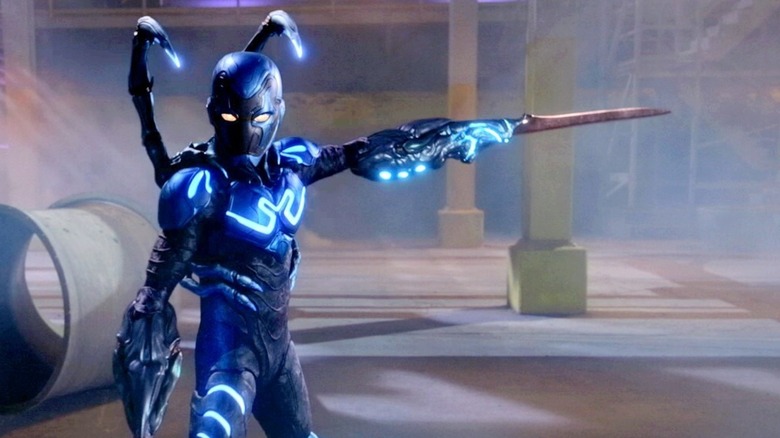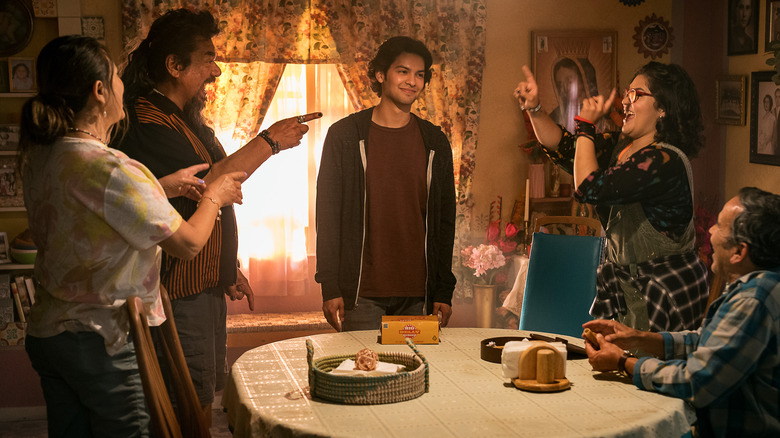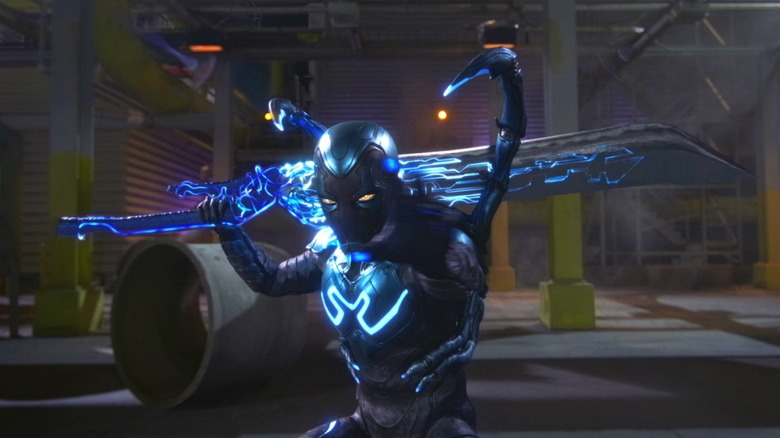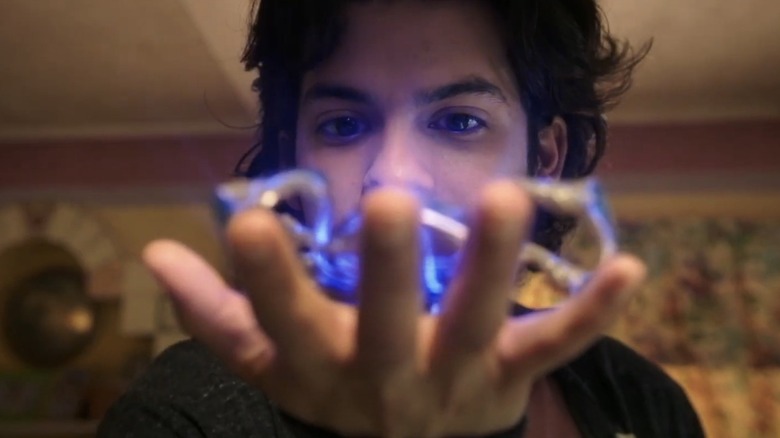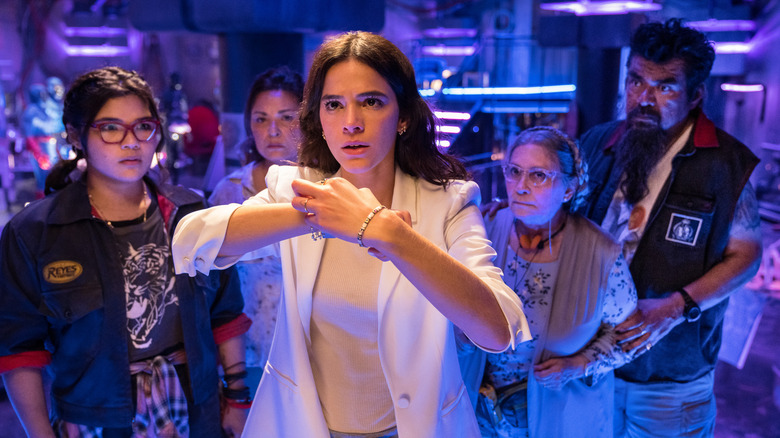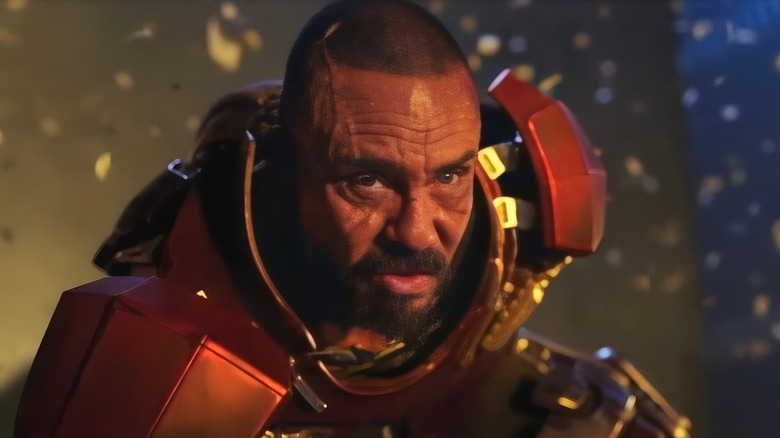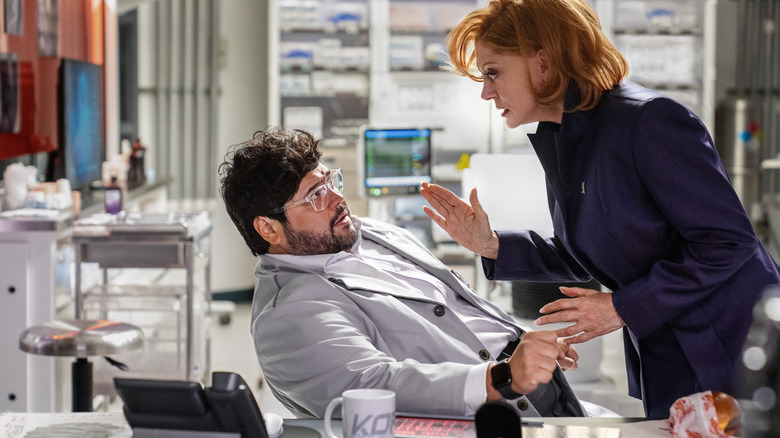Blue Beetle Director On The Film's Cultural Specificity, Real-World Allusions, And More [Exclusive Interview]
We are 15 years into superheroes dominating Hollywood, and after so many years, these movies have started to stagnate creatively. In many ways, superhero movies are now like action shonen anime: They all follow very strict formulas and can feel rather same-y, but it is the small ways in which each title is different from the others that makes them entertaining. Just like "Jujutsu Kaisen" is basically just a modern and more horror-inspired "Naruto," the latest DC movie, "Blue Beetle," stands out because of how it adds a focus on family and cultural specificity to the superhero formula.
That's the film's biggest strength from the get-go. Jaime Reyes' (Xolo Maridueña) family is fully aware of his superpowers and of the alien scarab that attached itself to his spine. They are an essential part of the story, the secret weapon that makes Jaime stronger and more powerful, rather than being a source of drama regarding whether or not they find out about his powers.
Moreover, the film's cultural specificity makes even the more formulaic elements of the story feel fresh by making them feel real, grounded in a real history of Mexican and Latino resilience. We see this in the way the family speaks Spanish constantly, in the specific references to telenovelas and Mexican superheroes that they use, and in the music they listen to.
/Film talked to "Blue Beetle" director Ángel Manuel Soto about how the cultural specifics in the film make it feel universal, grounding the villain's backstory in a real American atrocity, and more.
Note: This interview has been lightly edited for clarity and brevity.
'The only thing that could have prevented this was the studio'
There is a cultural specificity to the film that we haven't really seen before in superhero movies, and the Reyes family members aren't just Pan-Latino, but specifically Mexican. Why was this important for the film?
I think we've been psychologically and pathologically inculcated a fallacy by the hegemony that our specificity is not universal, that the white and gringo are universal. The truth of the matter is that we're all universal if we embrace our true selves. We Latinos watch Korean movies, Japanese movies, European movies, and we connect with their specificity because Latinos were never given that change because we were told you couldn't, and I never agreed with that feeling, that thought. It is an institutionalized philosophy, and Hollywood has perpetrated it.
So for me, I wanted to start from the premise that the universality of our cultures exists in our specificity. And if we are honest and free to be authentically us, and we don't have to be like someone else, it can still reach a general audience even if they don't look like us. To me, it was important for writer Gareth Dunnet-Alcocer as a Mexican, for me as a Puerto Rican, and to the actors as Mexicans, to be themselves, to allow this to be a movie where we take ourselves seriously, but also enjoy ourselves and express ourselves freely. To me, it was important to not have to reinvent the wheel at the first try, but to instead use nostalgia to make a throwback to the movies we liked as kids and insert ourselves in those scenes as the heroes of the movie, embracing authenticity. After, we can reinvent the wheel.
The only thing that could have prevented this was the studio, and from the beginning, I told them if they were going to tell me how big the explosions were going to be, they could not tell me how Latino my movie was going to be.
'Why not embrace the characters or elements that are specific, which also have a Pan-Latino appeal?'
One thing I love was the references to cultural touchstones like "El Chapulín Colorado" and "María la del Barrio." Could you talk about those references and introducing these things to a wider audience?
Just as we consume other countries' popular cultures, we can't leave other people ignorant to the things that connect us as Latinos, because though our countries have their own idiosyncrasies, truths, and specific cultural identities, there are also more things that unite us within a Latin American collective. For me, it was very important not only to pay homage and honor that first Latin American hero we all collectively grew up with, but highlight that a Mexican in Querétaro like Gareth, and a Puerto Rican like me, being so far away, still can say that our first exposure to a superhero was El Chapulín, because he was in every Latin American's home.
So we thought, why not embrace the characters or elements that are specific, which also have a Pan-Latino appeal? And through that, we can celebrate the intersectionality of our cultures. It doesn't have to be Mexican for me to say it is also mine, it is also yours. Same with Puerto Rico: Reggaetón is no longer ours. It belongs to the world, even if it came from there. Same with "Maria la del Barrio," and novelas. The references in the movie are both a celebration to the things that unite us collectively as Latino, and also references we are canonizing in this fictional world.
'It was important that we taught through the film that us Latinos have popular music that is great and fun'
The film also has a fantastic and rather diverse soundtrack of Latino sounds. How was it to assemble that aspect of the film?
That process was one of the most fun. I did it with "Charm City Kings," and "La Granja," early in the creative pre-production process, in that moment of world-building. And I come from a rather musical background. Not that I am a musician, but I did play in a band and you can't really escape music in Puerto Rico. All your life, since you're a kid walking to school, crossing the park or whatever, you have a soundtrack on all the time. Silence is rare.
So, to me, it was important to create this playlist that represented not only what the streets of Palmera City sound like, but also a playlist that was like a collection of all the songs in every member of the family's phones. This is a house where every genre goes, they are so many people with such different personalities, that I thought it ridiculous, that generalizing idea that only one genre of music defines Mexican, and one genre defines Caribbean, or Argentinian. Sure, we have our autochthonous music and that's fine and that is listened to, but just as Argentina has tanto, they also have Soda Stereo. Just as Puerto Rico has Nueva Trova and Menudo, they have reggaetón, and Mexico has not just rancheras, but also rap, rock in Spanish, and so on.
It was important that we taught through the film that us Latinos have popular music that is great and fun. We have music that we listen to, that we don't just listen to gringo music, even if we do consume it and we enjoy it — it is not the only music we listen to. And I wanted to put all these within our specificity, that we have music that transcends our borders, like Los Saicos, who created punk out of Peru but no one talks about, or using Soda Stereo at the end for a big John Hughes-style finale. To me, the music helped reclaim spaces from the past, of movies we liked and wanted to put ourselves and our cultures in. After we get to that point, then we can reinvent the wheel, but first we have to appropriate that which we were supposed to have at that time.
'I never wanted our characters to exist in a world of pure fantasy'
Can you talk about Nana, and the reveal of her past as a revolutionary? Because that was incredible.
This is a fantasy world, right? We have an alien scarab that comes to Earth and gives this kid powers, and he lives in a city that doesn't exist. And yet that doesn't mean we can't use visceral experiences from our community as a starting point. It doesn't mean that fiction can't come out of truth and feed off it. [HBO's] "Watchmen" used the Tulsa Massacre as a starting point, but we haven't had the chance to do that as Latinos, to explore within fantasy, at least in superhero stories. I never wanted our characters to exist in a world of pure fantasy. I wanted the characters' backgrounds, their past and their legacy, to be reflections of our reality.
So, as part of the fantasy and the surreal of seeing a grandma take a machine gun that weighs more than her, it is based on truth. We based the character on female guerrilleras, soldiers that fought with Zapata to free Mexico during the revolution, a badass group of women. We see our grandmothers as nice old ladies, but they've gone through a lot and are much stronger than any little macho guy that goes around threatening people. We wanted to honor these matriarchs that have always been in our lives, who are usually left in the background as props or baits, their roles as one-dimensional, and give them depth with a historical background. Because it is real. Nana's braids are real. These women existed. Of course, not like the movie, but we're using something from the past and celebrating it inside the world of fantasy. Because magical realism is very much a part of who we are.
It is the same way we have Jaime come home at the start of the movie and face problems that don't involve an alien invasion, but gentrification and displacement. These are things that affect us every day, so the villain is not a cartoony, "Look how bad I am," person, and she doesn't look evil, but her plan is to expropriate Latin America's resources and to have control over her interventions around the world. It's why we added a grounded backstory for Carapax, too, to talk about a reality people don't want to talk about.
'It was important that the film reflected that reality that is not taught at school'
Speaking of Carapax, his story is fascinating in that it brings in the real history of the School of the Americas. Can you talk about the decision to bring in that part of the story?
To me, it was important to explore that in Hollywood, Latinos are always introduced in the middle of the paragraph. We enter a scene and we're gangsters and narcos, we are violent and dishonest people, and no one questions why that is. And when a movie or a show explains why, it just says that we are like that because that's our nature. So, we've never been given the chance to explore the history of blood behind the violent behaviors in Latin America. And, come on, you don't have to be a rocket scientist or an erudite to do a simple Google search and learn about Yankee interventionism, and why that interventionism started in 1954 to protect the American [United] Fruit Company in Guatemala.
It was important for me to be able to show this villain who is not just Latino, but indigenous, and show why he is the way he is to a certain point. Because even though he is responsible for much of his actions, the reason why he is a villain is because his trauma was weaponized. And when you see it, you understand he is a victim of the endless perpetuating of violence in Latin America by the CIA through the School of the Americas, but no one talks about that. No one talks about the start of neoliberalism in the School of the Americas in 1973 with the murder of Allende and the placement of Pinochet.
It was important that the film reflected that reality that is not taught at school. It is why Susan [Sarandon's character] represents the Military Industrial Complex, and the rampant imperialism that exists in Latin America. She is a person that has been perpetrating trauma, and then using that trauma like the School of the Americas, which trained the locals so they'd invade their own people. There is nothing more nefarious than that, so it was important to me to have that exist in this movie, if only for a minute. Using fantasy to raise curiosity could help us be better informed and more emphatic.
When I joined the project, I wanted the movie to be somewhat anchored in realism, in real traumas that Latin America has experienced historically. But I wanted it to be recent, not to just go all the way back to Columbus, though we do tumble a statue of Columbus in the movie. We talk about the more recent and relevant history, the one that is not talked about, but should be remembered so it is not repeated.
And the name is a bit ridiculous, and some people may not realize this is actual history, so we intercut Carapax's flashbacks with archival footage of the School of the Americas to make it clear this is real.
'You don't have to wait for someone else to save you'
The character is also indigenous, and you bring Carapax's native language into the movie, too.
Yes, we had him unlock his memory, and his language. It is an allegory for how colonized or imperialist education works overtime to erase our history and make us forget where we come from, because it makes it easier to control. We wanted to make this situation where, at the end of the day, his memory is freed and he can look back to the source of the trauma, and understand everything that happened to him. His being able to talk in his native tongue is the most explicit way to show that he could return to his origin and empower himself by that origin, to close that chapter and sacrifice his own master for the greater good.
Lastly, the Reyes family uses the word "ánimo" as a mantra throughout the film, and it made me think of how Latino that word is and how hard it is to translate it.
The motto of "ánimo" was brought up by the screenwriter. He showed me a video of a guy in a pickup truck that has a big sticker with the word ánimo, and he's driving around the barrio shouting "ánimo" to the people. It was like a hope, a resilience, recognizing that things can be tough, but brother, we've endured worse. We have different ways of saying it, "Fua, pa' lante, tu puedes, dale, échale." It shows the resilient optimism that Latinos have to keep moving forward, which we wanted to personify in Alberto. It is him, and that mantra, that helps the Reyes' go forward after losing everything, because there's no way to go but forward. We start the movie with Alberto saying it, and at the end Jaime says it.
That is a beautiful legacy that we pass on to future generations. For me, though we talk about serious themes and real things in the movie, the intention is to shine a light, to not repeat. At the end of the day, it is that which allows us to prepare a better future for those who come next. That is the point of the movie, to have younger and future generations see themselves in a superhero who doesn't only look like them, but teaches that you don't have to wait for someone else to save you, that you can save yourself, with your family, your loved ones, and your community.
"Blue Beetle" is in theaters now.
